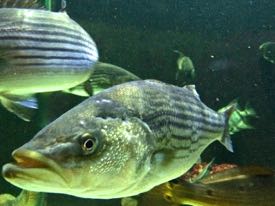The 2023 Chesapeake Bay dead zone is the smallest on record
The combination of pollution reduction practices and below-average rainfall result in a historically small dead zone
VIMS’ annual report of “dead-zone” conditions in the Chesapeake Bay indicates that hypoxic, low-oxygen conditions, in 2023 were at their lowest since monitoring began in 1985. These results concur with a separate report issued by the Chesapeake Bay Program in conjunction with the Maryland Department of Natural Resources (MD DNR).
“The low levels of hypoxia in 2023, despite the high temperatures, are truly surprising,” said Dr. Marjy Friedrichs, professor at William & Mary's Virginia Institute of Marine Science. “This may finally be clear evidence that our nutrient reduction strategies are improving water quality and fish and shellfish habitats.” Dr. Aaron Bever of Anchor QEA, LLC and co-author of the Chesapeake Bay Dead Zone Report Card with Friedrichs added: “It is great that the Bay has now had relatively low amounts of hypoxia for multiple years. This shows that nutrient reductions are having a positive impact on the health of the Bay and Bay habitat”.

Dead zones are areas of low oxygen (less than 2 milligrams per liter oxygen) that form in deep Bay waters when nutrients enter the water through polluted runoff and feed naturally-occurring algae.
This drives the growth of algal blooms, which eventually die and decompose, removing oxygen from the surrounding waters faster than it can be replenished. This creates low-oxygen—or hypoxic—conditions at the bottom of the Bay that limit habitat for crabs, oysters, fish, and other wildlife.
Researchers track Bay oxygen conditions using a variety of methods. Oxygen and nutrient levels are routinely measured as part of the Chesapeake Bay Water Quality Monitoring Program, a Bay-wide cooperative effort involving watershed jurisdictions, several federal agencies, 10 academic institutions, and more than 30 scientists. Since 1985, roughly 17 cruises have been conducted each year, with more cruises occurring in the warmer summer months when hypoxia becomes the greatest issue for the Chesapeake Bay ecosystem. All cruise data are freely available online at the Chesapeake Bay Program’s DataHub.
Based on these data, local weather information, and estimates of nutrients entering the Bay from the surrounding watershed, VIMS has developed and now operates a real-time three-dimensional Chesapeake Bay forecast model that predicts daily oxygen concentrations throughout the Bay. The Chesapeake Bay Environmental Forecast System (CBEFS) also provides daily estimates of other environmental conditions throughout the Bay, including water temperature, salinity levels, acidification metrics, as well as the percent chance of encountering harmful algal blooms, sea nettles, and vibrio in the Bay.

This year CBEFS demonstrated that relatively calm winds and warm temperatures resulted in hypoxia starting earlier than usual, as also occurred in 2022. However, hypoxia was uncharacteristically low throughout most of the summer, likely as a result of continued nutrient reductions in combination with below average precipitation. Rainfall plays an important role in the development of dead zones, as it washes nutrients from the land into the Bay. Precipitation was below-average for most of 2023. Estimates from the United States Geological Survey (USGS) show that freshwater flowing into the Bay was below average from October 1, 2022 - September 30, 2023, with 65,649 cubic feet of water per second compared to the long-term average of 79,000 cubic feet per second. In June, freshwater flows were in the historical lowest 25th percentile.
The 2023 dead zone could have been even smaller if it weren’t for the season’s above average temperatures and average wind speeds. Warmer air leads to warmer Bay waters, which in turn hold less oxygen and support higher rates of oxygen consumption by microorganisms. Faster wind speeds help mix oxygen into the deeper waters of the Bay, which can prevent hypoxic conditions. In addition to the weather conditions, the size and duration of the Bay's dead zone is affected by the amount of nutrients entering the Chesapeake from its surrounding watershed. Pollution-reducing practices put into place by Delaware, Maryland, New York, Pennsylvania, Virginia, West Virginia and the District of Columbia, help reduce the amount of nutrients that enter local waterways and the Chesapeake Bay from sources such as wastewater, agriculture, and stormwater runoff. It is estimated that between 2009 and 2022, the six watershed states and the District of Columbia have met 51% of the goal to reduce nitrogen and 60% of the goal to reduce phosphorus by 2025.
The 2023 Dead Zone Report Card is in agreement with water quality monitoring data that showed higher than average bottom oxygen concentrations, and is consistent with the Chesapeake Bay Program’s seasonal forecast produced earlier this year that suggested hypoxia in 2023 would be substantially below the long-term average.

